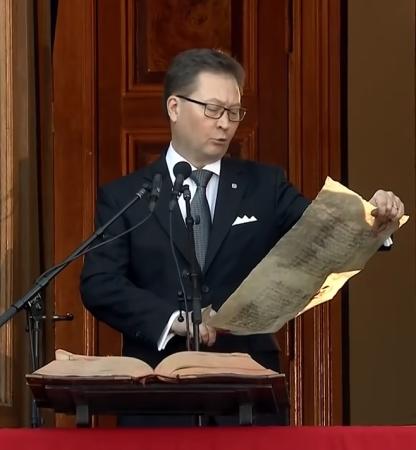A Declaration of Christmas Peace is announced in several Finnish cities on Christmas Eve. The oldest and most popular event is held at noon at the Old Great Square of the former Finnish capital Turku, where the declaration has been read since the 1320s. The Declaration of Christmas Peace is a tradition which launches the Christmas celebrations and in a way marks the official start of Christmas. The exact wording used during the first few centuries of the tradition has been lost over time, but the main contents of the declaration remain the same: the declaration is read out loud to remind people that Christmas Peace has begun, to advise people to spend the festive period in harmony, to threaten offenders with harsh punishments, and to wish all a merry Christmas!
A Declaration of Christmas Peace is announced in several Finnish cities on Christmas Eve. The oldest and most popular event is held at noon at the Old Great Square of the former Finnish capital Turku, where the declaration has been read since the 1320s. The most significant exceptions to this are thought to be the years of the Greater Wrath when Finland was under Russian occupation which lasted from 1712 to 1721, and the single years missed during both the 1917 militia strike and the Winter War year of 1939. There may also have been a break between 1800 and 1815.
The Declaration of Christmas Peace is a tradition which launches the Christmas celebrations and in a way marks the official start of Christmas. The exact wording used during the first few centuries of the tradition has been lost over time, but the main contents of the declaration remain the same: the declaration is read out loud to remind people that Christmas Peace has begun, to advise people to spend the festive period in harmony, to threaten offenders with harsh punishments, and to wish all a merry Christmas.
The Turku declaration has been broadcast by the Finnish Broadcasting Company since 1935. National television broadcasts started in 1983 and the Turku declaration has also been seen on the Swedish television since 1986. The event can be viewed via the internet as well. Besides Turku, the declaration is also announced in some of the oldest Finnish towns like Rauma, Porvoo, Pori and the Estonian city of Tartu. Nowadays the Declaration of Christmas Peace can be viewed live around the world via the Internet.
Music has been a part of the event since the 17th century. Traditional instruments used include the bagpipes, timpanis and various string instruments. The current format was established in 1903. It starts with the hymn A Mighty Fortress Is Our God and is followed by the declaration which is announced by a city official at midday. As the declaration is read in Finnish and Swedish, the public sings the Finnish national anthem in both languages afterward. The event ends with March of the Men of Pori which is usually played by a local military band, usually from the Finnish Navy.
The present version of the Turku declaration was written down in 1827. English translation of the Turku Declaration of Christmas Peace:
Tomorrow, God willing, is the graceful celebration of the birth of our Lord and Saviour;
and thus is declared a peaceful Christmas time to all, by advising devotion and to behave otherwise quietly and peacefully,
because he who breaks this peace and violates the peace of Christmas by any illegal or improper behaviour shall under aggravating circumstances be guilty
and punished according to what the law and statutes prescribe for each and every offence separately.
Finally, a joyous Christmas feast is wished to all inhabitants of the city.
[The following titles are not available in the PPL collection]
- Ashworth, T., Trench Warfare 1914-1918: the Live-and-Let-Live System, London, Pan, 2000.
- Boyle, D., Peace on Earth: the Christmas Truce of 1914, London, Endeavour Press, 2014.
- Brown, M. and S. Seaton, Christmas Truce: The Western Front, 1914, New York, Hippocrene Books, 2001. (Rev. and expanded edition, original 1984)
- Crocker, T.B., The Christmas Truce: Myth, Memory, and the First World War, Lexington, University Press of Kentucky, 2015.
- Eksteins, M., The Rites of Spring, New York, NY, Mariner Books, 2000.
- Weintraub, S., Silent Night: the Remarkable Christmas Truce of 1914, London, Pocket Books, 2002.
